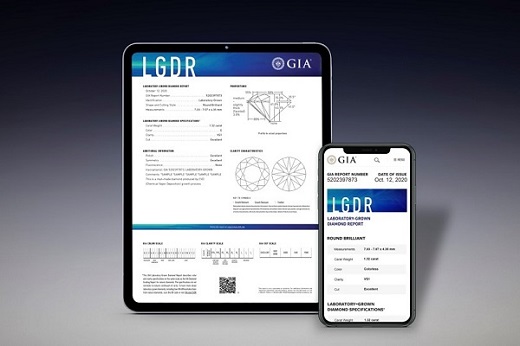|
|
GIA Now Giving Details of Lab-Grown Treatments
Mar 16, 2021 6:15 AM
By Joshua Freedman
|
|
|

RAPAPORT... The Gemological Institute of America (GIA) has started providing specific information on post-growth treatments for synthetic diamonds, marking the latest shift in its approach to the category.
The institute’s Laboratory-Grown Diamond Reports now say if there is evidence of a treatment to change the color of a stone, or if there is no evidence, a GIA spokesperson told Rapaport News Monday. Some stones carry the comment: “Whether this man-made diamond has been treated is currently undeterminable.”
Previously, all reports included a generic statement that the lab-grown diamond “may” have been treated. The changes went into effect in early March. The reports will continue to state the growth type: chemical vapor deposition (CVD) or High Pressure-High Temperature (HPHT).
The move comes amid discussions in the industry over whether “as-grown” diamonds — a marketing term used in the synthetics sector — should attract a premium. Color treatments are common in CVD material, as many crystals emerge from synthesis machines with a brown tinge.
“We made this change in response to feedback from our clients — manufacturers, retailers and brands — that there is interest in knowing about post-growth color treatments for laboratory-grown diamonds,” the GIA spokesperson commented.
Speaking to the Rapaport Diamond Podcast in September, GIA CEO Susan Jacques said the organization “didn’t feel that it was essential for consumers to know [if a lab-grown diamond] has or has not been treated,” as “consumers are not that granular in the expectation of what they’re learning.” However, she added that the GIA would provide a letter stating whether it had detected a treatment, where necessary.
Since then, the International Gemological Institute (IGI), one of the major players in the lab-grown space, has added specific treatment details to its lab-grown reports.
The GIA introduced its Laboratory-Grown Diamond Reports, or LGDRs, in October. Importantly, the documents provide the same specific color and clarity grades that the organization offers for natural diamonds — the first time it had done this. Its previous synthetics reports used descriptive terms such as “near colorless” and “very slightly included.”
“If you look through that whole journey until [the GIA] launched the LGDR, you clearly see a pattern of...evolving transparency regarding the grading of lab-grown diamonds,” said Leon Peres, CEO of Green Rocks, a producer and supplier of untreated synthetic diamonds and part of Ofer Mizrahi Diamonds.
Image: A GIA lab-grown report. (GIA)
|
|
|
|
|
|
|
|
|
|
Tags:
as-grown, chemical vapor deposition, cvd, Gemological Institute of America, GIA, Green Rocks, High Pressure-High Temperature, HPHT, IGI, International Gemological Institute, Joshua Freedman, Laboratory-Grown Diamond Reports, Ofer Mizrahi Diamonds, Rapaport Diamond Podcast, Susan Jacques, Synthetic diamonds, Synthetics, treatments
|
|
|
|
|
|
|
|
|
|
|

|
|